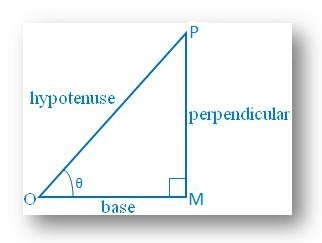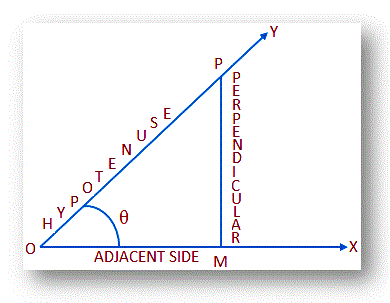Subscribe to our ▶️ YouTube channel 🔴 for the latest videos, updates, and tips.
Relations Between the
Trigonometric Ratios
Fundamental relations between the trigonometric ratios of an angle:
To know the relations between the trigonometric ratios from the above figure, we see;
sin θ = perpendicular/hypotenuse = MP/PO and
cosec θ = hypotenuse/perpendicular = PO/MP
It is clear that one
is the reciprocal of the other.
So, sin θ = 1/cosec θ and
cosec θ = 1/sin θ ………. (a)
Again, cos θ = base/hypotenuse = OM/OP and
sec θ = hypotenuse/ base = OP/OM
One is reciprocal of the other.
That is, cos θ = 1/sec θ and sec θ = 1/cos θ ………. (b)
So, tan θ = perpendicular/base = MP/OM and cot θ = base/perpendicular = OM/MP
tan θ = 1/cot θ and cot θ = 1/tan θ ………. (c)
Moreover, sin θ/cos θ = (MP/OP) ÷ (OM/OP) = (MP/OP) × (OP/OM) = MP/OM = tan θ
Therefore, sin θ/cos θ = tan θ ………. (d)
and cos θ/sin θ = (OM/OP) ÷ (MP/OP) = (OM/OP) × (OP/MP) = OM/MP = cot θ
Therefore, cos θ/sin θ = cot θ ………. (e)
Sin θ = PM/OPCos θ = OM/OP
Tan θ = PM/OM
Csc θ = OP/PM
Sec θ = OP/OM
Cot θ = OM/PM
Now from the right-angled triangle POM we get;
PM2 + OM2 = OP2 ……………. (i)
Dividing both sides by OP2 we get,
PM2/OP2 + OM2/OP2 = OP2/OP2
or, (PM/OP)2 + (OM/OP)2 = 1
or, sin2 θ + cos2 θ = 1
Again, dividing both sides of (i) by OM2
PM2/OM2 + OM2/OM2 = OP2/OM2
or, (PM/OM)2 + 1 = (OP/OM)2
or, tan2 θ + 1 = sec2 θ
Finally, dividing both of (i) by PM2 we get;
PM2/PM2 + OM2/PM2 = OP2/PM2
or, 1 + (OM/PM)2 = (OP/PM)2
or, 1 + cot2 θ = csc2 θ
Corollary 1: From the relation sin2 θ + cos2 θ = 1 we deduce that
(i) 1 - cos2 θ = sin2 θ and
(ii) 1 - sin2 θ = cos2 θ
Corollary 2: From the relation 1 + tan2 θ = sec2 θ we deduce that
(i) sec2 θ - 1 = tan2 θ and
(ii) sec2 θ - tan2 θ = 1
Corollary 3: From the relation 1 + cot2 θ = csc2 θ we deduce that
(i) csc2 θ - 1 = cot2 θ and
(ii) csc2 θ - cot2 θ = 1
This is how the ratios are related to show that one is the reciprocal of the other according to the relations between the trigonometric ratios.
Relations Between the Trigonometric Ratios
Problems on Trigonometric Ratios
Reciprocal Relations of Trigonometric Ratios
Problems on Trigonometric Identities
Elimination of Trigonometric Ratios
Eliminate Theta between the equations
Verify Trigonometric Identities
From Relations Between the Trigonometric Ratios to HOME PAGE
Didn't find what you were looking for? Or want to know more information about Math Only Math. Use this Google Search to find what you need.




New! Comments
Have your say about what you just read! Leave me a comment in the box below. Ask a Question or Answer a Question.